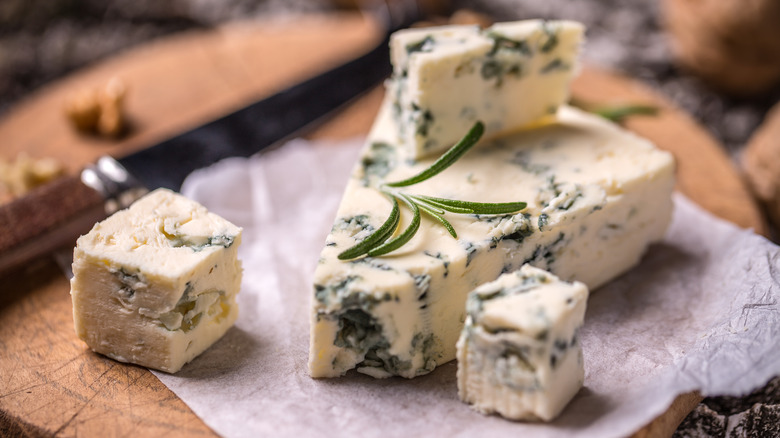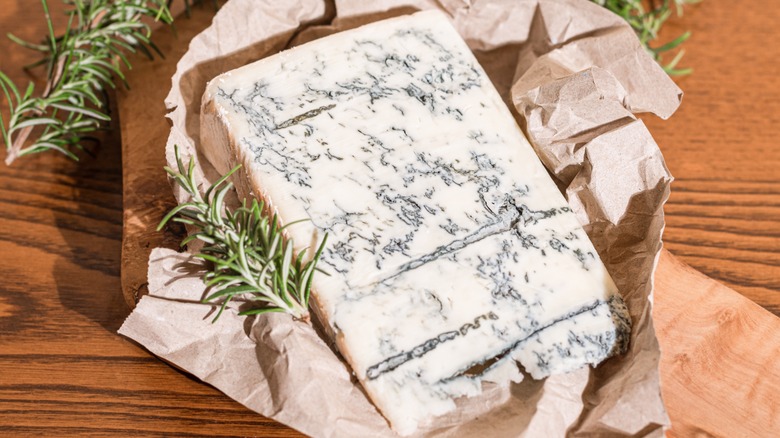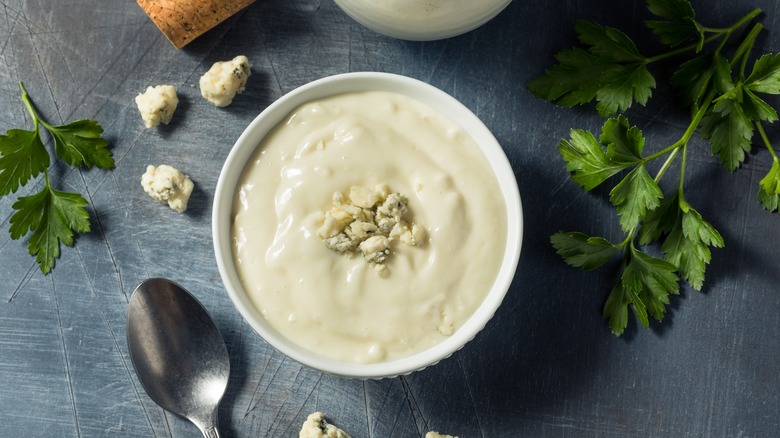What's The Difference Between Gorgonzola And Blue Cheese?
For a lot of people who love funky cheese, there's one type that stands out among the rest: blue cheese. Blue cheese gets its signature hue from its distinctive blue veins (actually mold, but not a dangerous kind). Although fuzzy dark mold is the telltale sign blue cheese has gone off, if that stuff isn't present, it's a cheese lover's dream. But what about gorgonzola? Gorgonzola seems pretty similar to blue cheese, so what's the difference?
Actually, gorgonzola isn't different from a blue cheese because it is, in fact, a type of blue cheese. But the two aren't synonymous since there are also plenty of other cheeses that fit in the "blue" category, such as roquefort, stilton, cambozola, danablu, cabrales, etc. This is the old rectangle-square bit, where all squares are rectangles, but not all rectangles are squares. Gorgonzola, though, has a lot of qualities that set it apart from its blue cheese brethren, such as flavor, color, texture, and even nation of origin.
Gorgonzola looks different than its cousins
The thing about blue cheese is it doesn't just come from one region. Various countries have their own versions, such as France's roquefort, Spain's cabrales, Germany's cambozola, Denmark's danablu, America's maytag, and England's stilton. Gorgonzola, meanwhile, comes from Italy, specifically northern Italy in the Lombardy region. The legend about its creation is that it was accidental, but while it's not clear whether or not that's true, we know it gets its name from Stracchino di Gorgonzola — not the town where it was created but the one where it was first traded heavily. And while different blue cheeses can be made with different types of milk like sheep or goat, gorgonzola comes from cow's milk.
Visually, gorgonzola's veins don't look like those of most of its brethren, as they tend more toward green than blue — and they also tend to be long, thin veins as opposed to the spots present in many other blue cheeses. The reason here is gorgonzola's method of production, which involves inserting metal rods into wheels of cheese to allow air circulation, leading to the mold formation that gives blue cheese its distinctive taste and appearance.
Gorgonzola is generally milder and creamier than its cousins
But what about that taste? How does gorgonzola compare to its brethren? All blue cheese packs a flavor punch, and gorgonzola is no exception, but it's generally significantly milder than other blue cheeses. Some of this does depend on which gorgonzola variety you get — gorgonzola dolce is milder and creamier, while gorgonzola piccante has more of a kick and is harder — but pretty much all gorgonzola tends to be less salty, less intensely funky, and creamier than others in its category.
These tendencies make gorgonzola one of the best blue cheeses for melting or spreading on a sandwich, as many other varieties are too dry to do so effectively. Gorgonzola is also one of the more common choices for homemade blue cheese dressing for these same reasons — especially for those looking for a milder flavor. So while there's no wrong answer when it comes to blue cheese, if you like the taste but want to ease up on the funk, gorgonzola might be the pick for you.


